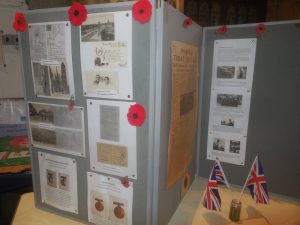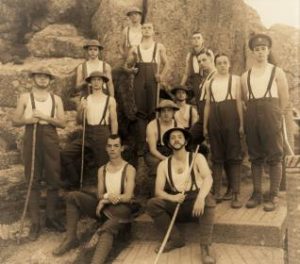
 Exhibition in St Sampson’s church, to show how the two world wars, and all the other wars of the last century, affected the families of the people who have lived in South Hill Parish, during that time, or live here now.
Exhibition in St Sampson’s church, to show how the two world wars, and all the other wars of the last century, affected the families of the people who have lived in South Hill Parish, during that time, or live here now.
 Exhibition in St Sampson’s church, to show how the two world wars, and all the other wars of the last century, affected the families of the people who have lived in South Hill Parish, during that time, or live here now.
Exhibition in St Sampson’s church, to show how the two world wars, and all the other wars of the last century, affected the families of the people who have lived in South Hill Parish, during that time, or live here now.Linkinhorne History Group, exhibition to mark the centenary of the end of WW1 – and its effect on the Parish of Linkinhorne – is now up in the Gallery at Sterts. This exhibition includes illustration, information, artefacts and one of the newly restored Linkinhorne Rolls of Honour for WW1. This exhibition is free and will remain at Sterts until the latter end of November. The Gallery is open during Box Office hours.
We will also be mounting another, quite separate, small exhibition to augment the centenary celebrations at Rilla Mill Village Hall where there will be a Victory Tea and Dance on Saturday November 10th – where the second of the restored Rolls of Honour will be officially handed back to Rilla Mill.
Also, as part of our joint collaboration with Sterts, the Sterts Youth Theatre Group will enact a ‘walking play’, at sets around various locations on the Sterts campus, based on the research we have provided them with about the ‘100 men of Linkinhorne’ and the stories of their service in WW1. This will begin at 7.00pm on November 4th.
And please don’t forget our talk on November 21st at the Cross Link Room, Upton Cross, where our guest speaker will be Major Hugo White who will further enlighten us with a talk entitled “The Role of the DCLI in WW1”.
Peter Sharpe & Mike Todd.
LINKINHORNE History Group EMAIL : secretarylhg@btinternet.com
Minefield
How can a soldier deal with memories of war? What memories do they repress – and which do they cherish?
Three Argentine and three British veterans from both sides of the 1982 Falklands/Malvinas conflict came together for this remarkable show exploring the treacherous minefield of their memories, through theatre, film and live rock music.
MINEFIELD is an enthralling piece of documentary theatre by Argentinian actor and director Lola Arias – compassionate, cathartic and astonishingly moving. Performed to enormous acclaim in both Britain and Argentina and have taken the crew on tour to Paris, Frankfurt, Angers and Montpellier. The show takes you from the horrors of the battlefield to today’s uncertainties, with brutal honesty and startling humour. See more here
Cast: David Jackson, Lou Armour, Gabriel Sagastume, Ruben Otero, Sukrim Rai, Marcelo Vallejo
Dave Jackson lives in Trevigro, Congratulations on the success of Minefield and the wedding of your daughter in September. What an amazing time for you all.


Golliwogs
The origins of the Golliwog begin with the British soldiers who occupied Egypt near the end of the 1800’s. Egyptian labourers working for the British bore the letters W.O.G.S. on their armbands, indicating that they were Working On Government Service. These labourers were spoken of as Ghuls- the Arabic word for desert ghosts – by the British troops. The children of the Egyptians played with black stuffed material dolls. These dolls in turn were given as gifts or purchased by the soldiers returning home to England. These dolls became known as Ghuliwogs, a name which become Golliwog
Florence Kate Upton, struck upon the character in 1895. Born into an eccentric English family  who had recently emigrated to the United States, Florence found work as an illustrator and formulated the idea for a children’s book. Stuck for a main character, her aunt, found an old battered black-face rag doll in the attic. “ I called him ‘Golliwogg’” The Adventures Of Two Dutch Dolls And A Golliwogg, was soon published.
who had recently emigrated to the United States, Florence found work as an illustrator and formulated the idea for a children’s book. Stuck for a main character, her aunt, found an old battered black-face rag doll in the attic. “ I called him ‘Golliwogg’” The Adventures Of Two Dutch Dolls And A Golliwogg, was soon published.
In this tale, the Golliwogg was initially described as ‘a horrid sight, the blackest gnome’, but turns out in fact to be good, loveable and brave, with a ‘kind face’.
He proved an instant hit with the British public, and Florence proceeded to publish a whole series of Golliwogg adventures.
They failed to trademark the Golliwogg character, and after the books had proved such a hit, toy companies jumped on the bandwagon. Slightly changing the name, they released a flurry of ‘Golliwog’ dolls, toys and badges.
Then, in 1910, John Robertson of jam manufacturing family saw children playing with a golliwog doll and decided it should be the company’s mascot. In the 1920s the company began producing Golliwog badges and enamel brooches which could be claimed by collecting tokens from jam jars. As more golliwog toys, watches and dinner sets were produced, the figure became part of everyday life and began to pop up in numerous children’s books.
It was in some of these stories, however, that they fell foul of the unpleasant racist stereotyping that has made the golliwog such a contentious figure in recent years. Children’s author Enid Blyton is seen as a major culprit, after portraying golliwogs in her Noddy stories as naughty thieves who once pinched Noddy’s prized yellow car.
Meanwhile, the word ‘wog’ began to be used as a derogatory word for black people. First popularised during World War II, it was uttered by some British soldiers as a slur against North Africans and other dark foreigners. By the 1960s, both the use of the term ‘golliwog’ and the dolls themselves were under increasing attack. Seen at best as racially insensitive and at worst as racist and vicious, golliwogs were gradually removed from public life. In 1983, the Greater London Council banned Robertson’s products from its jurisdiction, and in 1988 the character was no longer used in TV advertising.
Third Light A play by local Linkinhorne resident and historian Simon Parker was at The  Minack Theatre September 10 -14th.
Minack Theatre September 10 -14th.
Amongst the 13 soldier cast, is local lad Thomas Bariball from Polhilsa.
Imagine a Cornish village whose men all came home from the trenches. Imagine a war memorial honouring the living, not the dead. Imagine a place symbolising hope amid horror. Through immersive drama, live brass band and contemporary dance, Third Light tells the unique and moving story of Herodsfoot. A play based on the true story of the thirteen men of Herodsfoot, who went to serve in the First World War and all came home. Conceived and written by local Linkinhorne historian, directed by Nicola Rosewarne, choreographed by Ben Dunks, designed by Meier Williams, produced by Sarah Pym. Performed by an ensemble of professional and community actors and dancers, with music played live by St Pinnock Brass Band led by David Johnson. Continue reading
Commonwealth War Graves
Some of you will have seen the Commonwealth War Graves Commission sign which has gone up outside St Sampson’s church. If you try to find the usual Portland stone headstones you will search in vain.
John Henry Rogers and Aaron Dennis are commemorated in the churchyard not with official war commission memorials but with personal gravestones. There are no Commonwealth War Graves Commission memorials in St Sampson’s churchyard.
John Henry Dennis was Chief Stoker aboard HMS Earnest when he died on Tuesday 8th February 1916, age 39.
Aaron Rogers was a Petty Officer, on HMS Vivid, who died on Thursday February 10th, age 40.
For reasons unknown, neither of these men’s names appears on the war memorial in Golberdon.
Their graves can be found in the churchyard next to each other in the row of graves nearest to the road wall.
Thank You Miranda Lawrence-Owen for this information.
 The final resting place of Percy Jenkin
The final resting place of Percy Jenkin
Percy’s parents, James and Mary Jenkin lived at Lower Downgate with their four daughters and five sons, most of whom who were born there and all baptised, either at home or Downgate Chapel, as Bible Christians. James was a miner although a few years later, he was recorded as being an invalid. That didn’t stop his eldest son George working in the mines too. Next in the family was Alfred who joined the Territorial Force. Then came Ephraim who joined the Royal Navy and was a stoker, first class, on HMS Vivid. Percy was next and he went to work for Mr. Lawry Rickard as a live-in waggonner at Manaton. The youngest brother Stanley got work at Trewassick for Mr. Nicholas Coad. He lived in, and looked after their cattle. Continue reading
 Esme and Seth Blaze show their support for Callington Town Band’s Community project, ‘And Some Came Home’, when they put their tokens in the Town Band ‘Bags of Help’ slot at Callington Tesco. With just a week or so to go they are hoping that the Town Band, in which both their parents play, will be a worthy winner.
Esme and Seth Blaze show their support for Callington Town Band’s Community project, ‘And Some Came Home’, when they put their tokens in the Town Band ‘Bags of Help’ slot at Callington Tesco. With just a week or so to go they are hoping that the Town Band, in which both their parents play, will be a worthy winner.
And remember that you can support the project in other ways by coming along to the first Singing Workshop in Callington Town Hall at 10am on July 21st or by volunteering to act. Contact Shirley Morse (01579 360336 or shirleyamorse@gmail.com) for more information.
This is the first event in the re-running of ‘And Some Came Home’, the successful community commemoration of WW1 that was first performed in 2014.
With a cast of local singers, actors and musicians the 2018 performances will take place in the Town Hall on October 26th and 27th with free admission.
If you can’t make it to the first session and would like to take part in any capacity then please contact Shirley Morse now on 01579 350336 or shirleyamorse@gmail.com
Family Connections.
DID YOU KNOW that there is a South Hill Guest Book linked to the South Hill Connection website?
Our Guest Book link has been tucked away at the bottom right hand corner of the Home page, and as the list of up-coming events has got longer, the Guest Book has been pushed almost into oblivion! I will shortly be editing the page to bring it back into the limelight.
Entries are moderated, so only bona fide comments are visible to the public.
Recently, there have been a couple of new entries on the Guest Book. In September a message was left by Elizabeth Myers in Cheshire:
My paternal grandmother (nee Elizabeth Lark) was Cornish and her (very faded) baptism certificate states that she was baptised on the 14th November 1856 in (what looks like) “Lanteague” in the parish of South Hill. The minister’s name is also unreadable. Does Lanteague or a similar name ring bells with anyone please, I would love to know? My family history researches are extensive but this is still a mystery. She and my grandfather John Myers settled in his home town of Dalton-in-Furness in what is now Cumbria. Many thanks.
And in November, from Joy Hungerford in Kent:
My SYMONS family come from South Hill; earliest known, John, b about 1600, then Sampson, Sampson (whose Will mentions Higher Manaton and Maders), Rachel (who married William WEARING). Continue reading
Recently our church received a beautiful quilted banner from South Hill Piece Makers of St Sampson, the patron Saint of our Church, but who was he? Why is this church dedicated to him? We know a few things basis in historical fact.
Of all the so-called ‘Cornish’ saints, Sampson is the only one for whom there appears to be documentary evidence written at the time he was alive: there is a reference to a bishop, probably our St Sampson signing his name with other bishops who attended a church council in Paris in 562. Sampson also has the distinction of being the only ‘Cornish’ saint whose biography, was written less than 200 years after his death.
Sampson was the son of a noble family from South Wales, born in the early 500s. He was regarded as a miraculous child because he was born when his parents had long given up hope of having a child and was named after the Biblical Samson in the book of Judges. He was educated in a monastery at Llantwit Major where he eventually became ordained. Continue reading